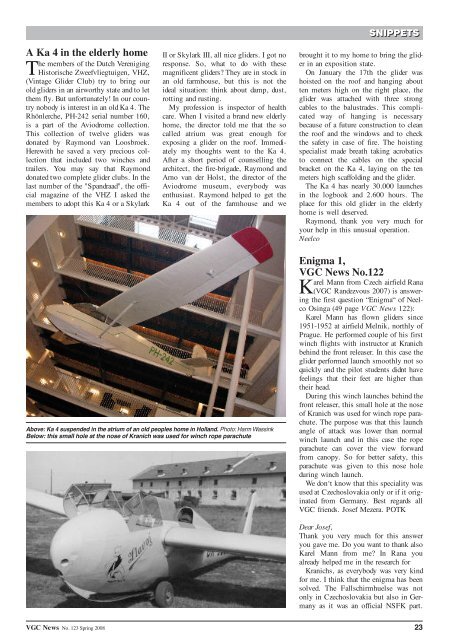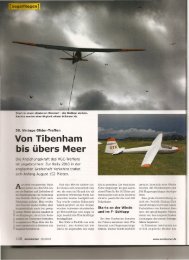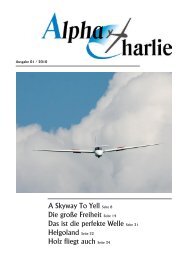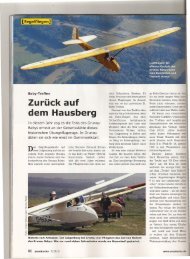Download - Vintage Glider Club
Download - Vintage Glider Club
Download - Vintage Glider Club
Create successful ePaper yourself
Turn your PDF publications into a flip-book with our unique Google optimized e-Paper software.
A Ka 4 in the elderly home<br />
The members of the Dutch Vereniging<br />
Historische Zweefvliegtuigen, VHZ,<br />
(<strong>Vintage</strong> <strong>Glider</strong> <strong>Club</strong>) try to bring our<br />
old gliders in an airworthy state and to let<br />
them fly. But unfortunately! In our country<br />
nobody is interest in an old Ka 4. The<br />
Rhönlerche, PH-242 serial number 160,<br />
is a part of the Aviodrome collection.<br />
This collection of twelve gliders was<br />
donated by Raymond van Loosbroek.<br />
Herewith he saved a very precious collection<br />
that included two winches and<br />
trailers. You may say that Raymond<br />
donated two complete glider clubs. In the<br />
last number of the "Spandraad", the official<br />
magazine of the VHZ I asked the<br />
members to adopt this Ka 4 or a Skylark<br />
II or Skylark III, all nice gliders. I got no<br />
response. So, what to do with these<br />
magnificent gliders? They are in stock in<br />
an old farmhouse, but this is not the<br />
ideal situation: think about damp, dust,<br />
rotting and rusting.<br />
My profession is inspector of health<br />
care. When I visited a brand new elderly<br />
home, the director told me that the so<br />
called atrium was great enough for<br />
exposing a glider on the roof. Immediately<br />
my thoughts went to the Ka 4.<br />
After a short period of counselling the<br />
architect, the fire-brigade, Raymond and<br />
Arno van der Holst, the director of the<br />
Aviodrome museum, everybody was<br />
enthusiast. Raymond helped to get the<br />
Ka 4 out of the farmhouse and we<br />
SNIPPETS<br />
brought it to my home to bring the glider<br />
in an exposition state.<br />
On January the 17th the glider was<br />
hoisted on the roof and hanging about<br />
ten meters high on the right place, the<br />
glider was attached with three strong<br />
cables to the balustrades. This complicated<br />
way of hanging is necessary<br />
because of a future construction to clean<br />
the roof and the windows and to check<br />
the safety in case of fire. The hoisting<br />
specialist made breath taking acrobatics<br />
to connect the cables on the special<br />
bracket on the Ka 4, laying on the ten<br />
meters high scaffolding and the glider.<br />
The Ka 4 has nearly 30.000 launches<br />
in the logbook and 2.600 hours. The<br />
place for this old glider in the elderly<br />
home is well deserved.<br />
Raymond, thank you very much for<br />
your help in this unusual operation.<br />
Neelco<br />
Above: Ka 4 suspended in the atrium of an old peoples home in Holland. Photo: Harm Wassink<br />
Below: this small hole at the nose of Kranich was used for winch rope parachute<br />
Enigma 1,<br />
VGC News No.122<br />
Karel Mann from Czech airfield Rana<br />
(VGC Randezvous 2007) is answering<br />
the first question “Enigma“ of Neelco<br />
Osinga (49 page VGC News 122):<br />
Karel Mann has flown gliders since<br />
1951-1952 at airfield Melnik, northly of<br />
Prague. He performed couple of his first<br />
winch flights with instructor at Kranich<br />
behind the front releaser. In this case the<br />
glider performed launch smoothly not so<br />
quickly and the pilot students didnt have<br />
feelings that their feet are higher than<br />
their head.<br />
During this winch launches behind the<br />
front releaser, this small hole at the nose<br />
of Kranich was used for winch rope parachute.<br />
The purpose was that this launch<br />
angle of attack was lower than normal<br />
winch launch and in this case the rope<br />
parachute can cover the view forward<br />
from canopy. So for better safety, this<br />
parachute was given to this nose hole<br />
during winch launch.<br />
We don‘t know that this speciality was<br />
used at Czechoslovakia only or if it originated<br />
from Germany. Best regards all<br />
VGC friends. Josef Mezera. POTK<br />
Dear Josef,<br />
Thank you very much for this answer<br />
you gave me. Do you want to thank also<br />
Karel Mann from me? In Rana you<br />
already helped me in the research for<br />
Kranichs, as everybody was very kind<br />
for me. I think that the enigma has been<br />
solved. The Fallschirmhuelse was not<br />
only in Czechoslovakia but also in Germany<br />
as it was an official NSFK part.<br />
VGC News No. 123 Spring 2008 23







